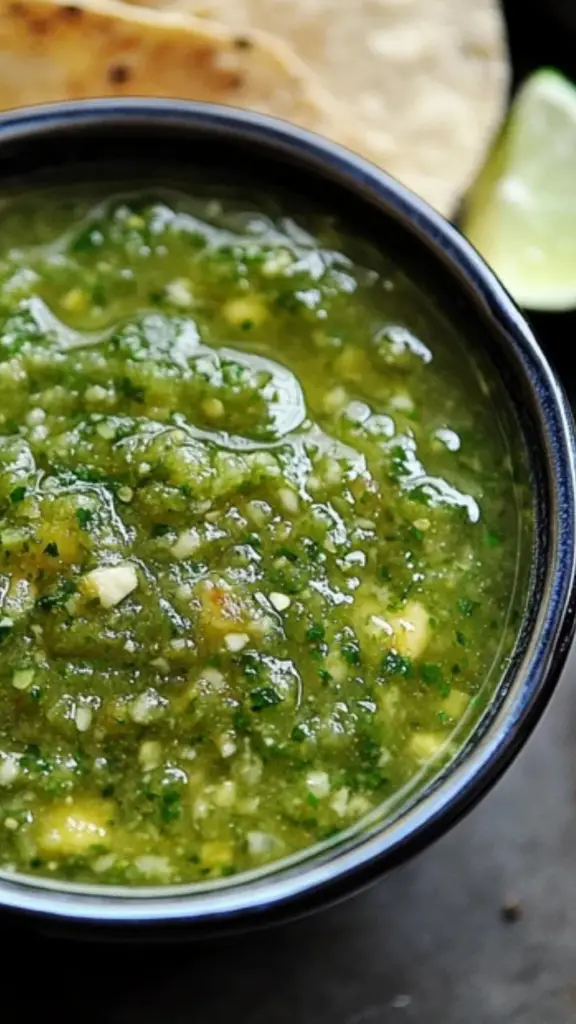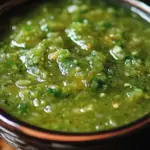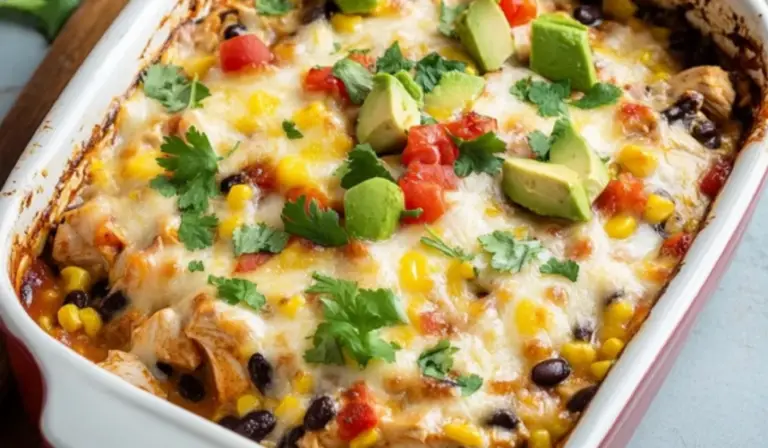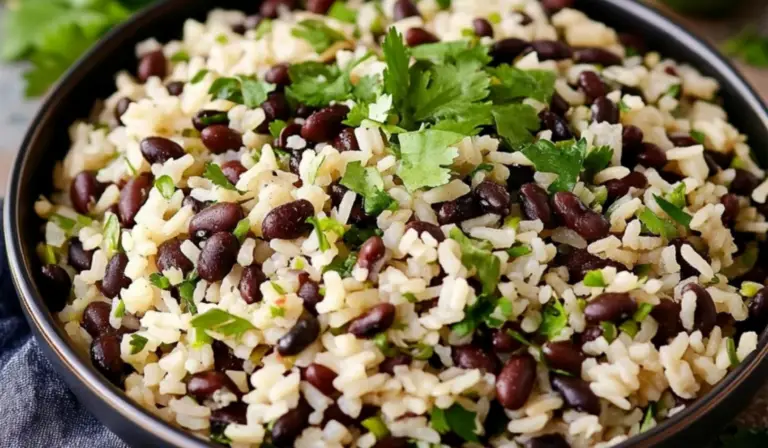A Beginner’s Guide to Homemade Tomatillo Salsa Verde
Salsa verde was one of the first homemade sauces I ever made. I was fresh out of college, cooking in a cramped kitchen with a single pan and a blender that had seen better days. Despite my lack of experience, I was determined to bring a little something special to taco night. I found a recipe online, bought a few unfamiliar ingredients—chief among them, tomatillos—and gave it a go. The result was a smoky, tangy green salsa that instantly upgraded everything I put it on. It was the first time I realized that impressive flavor didn’t require complicated technique or expensive tools. That first batch of salsa verde became my gateway into cooking from scratch.
PrintA Beginner’s Guide to Homemade Tomatillo Salsa Verde
🌿 Fresh, tangy, and so easy to make! This homemade tomatillo salsa verde is bursting with bright flavor—perfect for drizzling, dipping, or layering onto tacos. A must-have staple for any beginner cook! 🧄🧅🌶️
- Prep Time: 15 minutes
- Cook Time: 15 minutes
- Total Time: 30 minutes
- Yield: 5 cups 1x
Ingredients
- 2 pounds tomatillos, husks removed and washed thoroughly
- 6 jalapeños
- 4 garlic cloves
- 1 medium-large onion (white or yellow)
- 2/3 cup fresh cilantro leaves
- 2 teaspoons salt
Instructions
Step 1: Prepare your ingredients
Peel the husks from the tomatillos and rinse them under warm water. They have a sticky coating that can affect the taste if not washed thoroughly. Cut the onion in half, but leave the jalapeños and tomatillos whole. Gently crush the garlic cloves, but leave the skins on for roasting.
Step 2: Roast the vegetables
Preheat your oven to 400°F (200°C). Arrange the tomatillos, jalapeños, onion halves, and garlic cloves on a large baking sheet. Place in the oven and roast for 15 minutes, flipping the vegetables halfway through. The tomatillos should soften and begin to char slightly, the jalapeños will blister, and the garlic will become fragrant.
Step 3: Cool and prep for blending
Once roasted, let the ingredients cool for a few minutes. Peel the garlic cloves. Remove the stems from the jalapeños and, if you want a milder salsa, remove the seeds as well. Roughly chop the onion and jalapeños.
Step 4: Blend the salsa
Add the roasted tomatillos, onion, garlic, and jalapeños to a blender or food processor. Toss in the cilantro and salt. Pulse until everything is well combined. For a chunkier salsa, blend less. For a smoother texture, blend longer. Taste and adjust the seasoning—add more salt if needed, or a squeeze of lime juice for brightness.
Step 5: Store and enjoy
Transfer the salsa to a bowl or jar. Let it sit for 10–15 minutes so the flavors can meld. Serve immediately or store in an airtight container in the refrigerator for up to a week.
Notes
- Roasting is key: Don’t skip the oven step. Roasting intensifies the flavor and adds a subtle smokiness that makes the salsa rich and complex.
- Watch the garlic: Garlic burns quickly. If your oven runs hot, check around the 10-minute mark. Burnt garlic can make the salsa bitter.
- Control the heat: Taste your jalapeños before using them—spiciness can vary. Start with fewer if unsure. You can always add heat, but you can’t take it away.
- No blender? No problem: A food processor works great. Even a handheld immersion blender can do the trick. Just be careful if blending while the ingredients are hot.
- Cool before storing: Let the salsa cool to room temperature before sealing it in a container. This helps preserve the flavor and prevents condensation from watering it down.
- Double the batch: This salsa freezes well. Pour extra into freezer-safe containers or bags, label with the date, and thaw as needed. It’s a great time-saver for future meals.
This tomatillo salsa verde recipe is perfect for beginners. It’s simple, takes just 30 minutes from start to finish, and requires minimal prep. The ingredients are fresh, the steps are straightforward, and the outcome is a flavorful, vibrant salsa that works beautifully with everything from grilled chicken to scrambled eggs. It’s also a healthy alternative to store-bought sauces, packed with natural ingredients and no added sugars or preservatives. If you’re just starting out in the kitchen and looking for a quick win, this is the recipe to try.
Ingredients and Preparation
This recipe yields approximately five cups of salsa—enough for a dinner party or to store for future meals. The ingredient list is short but delivers a punch of flavor.
Ingredients:
- 2 pounds tomatillos, husks removed and washed thoroughly
- 6 jalapeños
- 4 garlic cloves
- 1 medium-large onion (white or yellow)
- 2/3 cup fresh cilantro leaves
- 2 teaspoons salt
Ingredient Notes and Substitutions:
Tomatillos are small, round fruits encased in a papery husk. Unlike green tomatoes, they have a tart, citrusy flavor. Fresh tomatillos are ideal, but if they’re out of season or unavailable, canned tomatillos can be used. Just make sure to drain them well before blending.
Jalapeños bring the heat. Leaving them whole during roasting enhances their smoky flavor. If you’re sensitive to spice, start with fewer peppers or remove the seeds before blending. If you want something even milder, consider swapping in poblano peppers or Anaheim chiles.
Garlic and onion provide the base flavor. Roasting them brings out their sweetness and mellows their sharpness. Any type of onion will work, though white or yellow onions are traditional in salsa recipes.
Cilantro adds freshness. If you don’t love the taste of cilantro, try substituting with fresh parsley and a splash of lime juice to maintain that bright herbal note.
Salt is essential to balance and enhance all the flavors. Don’t skip it, but feel free to adjust the amount to your taste.
Step-by-Step Instructions
This recipe involves roasting and blending. You don’t need much in the way of kitchen gear—a baking sheet, oven, and blender or food processor are all you need.
Step 1: Prepare your ingredients
Peel the husks from the tomatillos and rinse them under warm water. They have a sticky coating that can affect the taste if not washed thoroughly. Cut the onion in half, but leave the jalapeños and tomatillos whole. Gently crush the garlic cloves, but leave the skins on for roasting.
Step 2: Roast the vegetables
Preheat your oven to 400°F (200°C). Arrange the tomatillos, jalapeños, onion halves, and garlic cloves on a large baking sheet. Place in the oven and roast for 15 minutes, flipping the vegetables halfway through. The tomatillos should soften and begin to char slightly, the jalapeños will blister, and the garlic will become fragrant.
Step 3: Cool and prep for blending
Once roasted, let the ingredients cool for a few minutes. Peel the garlic cloves. Remove the stems from the jalapeños and, if you want a milder salsa, remove the seeds as well. Roughly chop the onion and jalapeños.
Step 4: Blend the salsa
Add the roasted tomatillos, onion, garlic, and jalapeños to a blender or food processor. Toss in the cilantro and salt. Pulse until everything is well combined. For a chunkier salsa, blend less. For a smoother texture, blend longer. Taste and adjust the seasoning—add more salt if needed, or a squeeze of lime juice for brightness.
Step 5: Store and enjoy
Transfer the salsa to a bowl or jar. Let it sit for 10–15 minutes so the flavors can meld. Serve immediately or store in an airtight container in the refrigerator for up to a week.
Beginner Tips and Notes
This recipe is approachable, but here are a few extra pointers to help first-time cooks succeed:
- Roasting is key: Don’t skip the oven step. Roasting intensifies the flavor and adds a subtle smokiness that makes the salsa rich and complex.
- Watch the garlic: Garlic burns quickly. If your oven runs hot, check around the 10-minute mark. Burnt garlic can make the salsa bitter.
- Control the heat: Taste your jalapeños before using them—spiciness can vary. Start with fewer if unsure. You can always add heat, but you can’t take it away.
- No blender? No problem: A food processor works great. Even a handheld immersion blender can do the trick. Just be careful if blending while the ingredients are hot.
- Cool before storing: Let the salsa cool to room temperature before sealing it in a container. This helps preserve the flavor and prevents condensation from watering it down.
- Double the batch: This salsa freezes well. Pour extra into freezer-safe containers or bags, label with the date, and thaw as needed. It’s a great time-saver for future meals.

Serving Suggestions
This versatile salsa pairs well with a wide range of dishes. Here are several ideas to help you make the most of your homemade tomatillo salsa verde:
Grilled Chicken or Beef: Spoon the salsa over grilled chicken breasts or flank steak for a simple, flavor-packed topping. The brightness of the tomatillos cuts through the richness of the meat, making it a perfect combo.
Tacos and Burritos: Use as a topping for chicken, beef, or vegetarian tacos. It adds freshness and spice that elevate even basic fillings.
Eggs and Breakfast Dishes: Stir a few spoonfuls into scrambled eggs or serve alongside a breakfast burrito. It’s also delicious drizzled over a fried egg with avocado toast.
Rice Bowls: Add to a rice bowl with grilled chicken, black beans, and roasted veggies. It acts as both a sauce and a flavor enhancer.
Dipping Sauce: Serve chilled with tortilla chips as a party appetizer or snack. It’s an easy, crowd-pleasing alternative to red salsa.
Soup Starter: Stir into chicken broth for a quick green chili soup. Add shredded chicken and rice or white beans for a hearty, comforting meal.
Marinade Base: Mix with olive oil and a bit of lime juice to create a marinade for chicken or beef before grilling.
Engagement Features
Cooking doesn’t need to be complicated to be impressive. This tomatillo salsa verde is a perfect example of that. With just a few simple ingredients and some basic techniques, you can create a vibrant, delicious sauce that tastes like something from your favorite taqueria. It’s proof that good cooking is about building confidence and learning to trust your taste.
Whether you’re a complete beginner or someone looking to add a new staple to your kitchen routine, this recipe is a great place to start. It teaches valuable skills—roasting, blending, adjusting seasoning—without overwhelming complexity. And the best part? You’ll have a jar of homemade salsa at the end that makes every meal better.
If you’ve made this salsa, I’d love to hear how it turned out. Did you stick to the recipe or add your own twist? Maybe you tried a different pepper or served it with something unexpected. Share your experience, ask questions, or swap ideas. Cooking is a journey, and recipes like this are stepping stones toward becoming a more confident and creative home cook.
Try it, tweak it, and enjoy it—then make it again. The more you cook, the better you get. And with this salsa verde in your repertoire, you’re already off to a bold, flavorful start.








